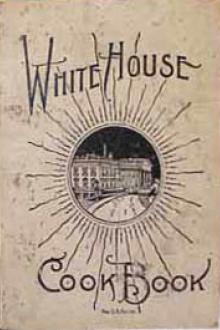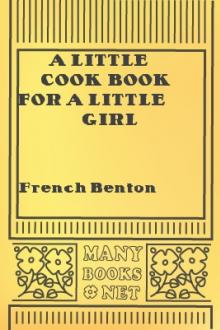The Whitehouse Cookbook (1887), Hugo Ziemann [world of reading .TXT] 📗

- Author: Hugo Ziemann
- Performer: -
Book online «The Whitehouse Cookbook (1887), Hugo Ziemann [world of reading .TXT] 📗». Author Hugo Ziemann
CHOCOLATE CREAM DROPS.
These are made or molded into cone-shape forms with the fingers, from the uncooked "French Cream," similar to that which is cooked. After forming into these little balls or cones, lay them on oiled paper until the next day, to harden, or make them in the morning and leave them until afternoon. Then melt some chocolate (the best confectioners') in a basin set in another basin of boiling water; when melted, and the creams are hard enough to handle, take one at a time on a fork and drop into the melted chocolate, roll it until well covered, then slip from the fork upon oiled or waxed paper, and set them aside to harden.
FRUIT AND NUT CREAMS.
Raisins seeded, currants, figs and citron, chopped fine, and mixed with the uncooked "French Cream," while soft, before the sugar is all mixed in, makes a delicious variety. Nuts also may be mixed with this cream, stirring into it chopped almonds, hickory nuts, butternuts, or English walnuts, then forming them into balls, bars or squares. Several kinds of nuts may be mixed together.
ORANGE DROPS.
Grate the rind of one orange and squeeze the juice, taking care to reject the seeds; add to this a pinch of tartaric acid; then stir in confectioners' sugar until it is stiff enough to form into balls the size of a small marble. This is delicious candy.
The same process for lemon drops, using lemons in place of orange. Color a faint yellow.
COCOANUT CREAMS.
Make the uncooked cream as in the foregoing recipe. Take the cream while soft, add fresh grated cocoanut to taste; add sufficient confectioners' sugar to mold into balls and then roll the balls in the fresh grated cocoanut. These may be colored pink with a few drops of cochineal syrup, also brown by adding a few spoonfuls of grated chocolate; then rolling them in grated cocoanut; the three colors are very pretty together. The coconut cream may be made into a flat cake and cut into squares or strips.
With this uncooked cream, all the recipes given for the cooked "French Cream," may be used: English walnut creams, variegated creams, etc.
COFFEE, TEA, BEVERAGES.Boiling water is a very important desideratum in the making of a cup of good coffee or tea, but the average housewife is very apt to overlook this fact. Do not boil the water more than three or four minutes; longer boiling ruins the water for coffee or tea making, as most of its natural properties escape by evaporation, leaving a very insipid liquid composed mostly of lime and iron, that would ruin the best coffee, and give the tea a dark, dead look, which ought to be the reverse.
Water left in the tea-kettle over night must never be used for preparing the breakfast coffee; no matter how excellent your coffee or tea may be, it will be ruined by the addition of water that has been boiled more than once.
THE HEALING PROPERTIES OF TEA AND COFFEE.
The medical properties of these two beverages are considerable. Tea is used advantageously in inflammatory diseases and as a cure for the headache. Coffee is supposed to act as a preventative of gravel and gout, and to its influence is ascribed the rarity of those diseases in Prance and Turkey. Both tea and coffee powerfully counteract the effects of opium and intoxicating liquors: though, when taken in excess, and without nourishing food, they themselves produce, temporarily at least, some of the more disagreeable consequences incident to the use of ardent spirits. In general, however, none but persons possessing great mobility of the nervous system, or enfeebled or effeminate constitutions, are injuriously affected by the moderate use of tea and coffee in connection with food.
COFFEE.
One full coffeecupful of ground coffee, stirred with one egg and part of the shell, adding a half cupful of cold water. Put it into the coffee boiler, and pour on to it a quart of boiling water; as it rises and begins to boil, stir it down with a silver spoon or fork. Boil hard for ten or twelve minutes. Remove from the fire and pour out a cupful of coffee, then pour back into the coffeepot. Place it on the back of the stove or range where it will keep hot (and not boil); it will settle in about five minutes. Send to the table hot. Serve with good cream and lump sugar. Three-quarters of a pound of Java and a quarter of a pound of Mocha make the best mixture of coffee.
VIENNA COFFEE.
Equal parts of Mocha and Java coffee; allow one heaping tablespoonful of coffee to each person and two extra to make good strength. Mix one egg with grounds; pour on coffee half as much boiling water as will be needed; let it froth, then stir down grounds, and let boil five minutes; then let it stand where it will keep hot, but not boil, for five or ten minutes, and add rest of water. To one pint of cream add the white of an egg, well beaten; this is to be put in cups with sugar, and hot coffee added.
FILTERED OR DRIP COFFEE.
For each person allow a large tablespoonful of finely ground coffee, and to every tablespoonful allow a cupful of boiling water; the coffee to be one part Mocha to two of Java.
Have a small iron ring made to fit the top of the coffeepot inside, and to this ring sew a small muslin bag (the muslin for the purpose must not be too thin). Fit the bag into the pot, pour some boiling water in it, and, when the pot is well warmed, put the ground coffee into the bag; pour over as much boiling water as is required, close the lid, and, when all the water has filtered through, remove the bag, and send the coffee to table. Making it in this manner prevents the necessity of pouring the coffee from one vessel to another, which cools and spoils it. The water should be poured on the coffee gradually so that the infusion may be stronger; and the bag must be well made that none of the grounds may escape through the seams and so make the coffee thick and muddy.
Patented coffeepots on this principle can be purchased at most house-furnishing stores.
ICED COFFEE.
Make more coffee than usual at breakfast time and stronger. When cold put on ice. Serve with cracked ice in each tumbler.
SUBSTITUTE FOR CREAM IN COFFEE.
Beat the white of an egg, put to it a small lump of butter and pour the coffee into it gradually, stirring it so that it will not curdle. It is difficult to distinguish this from fresh cream.
Many drop a tiny piece of sweet butter into their cup of hot coffee as a substitute for cream.
TO MAKE TEA.
Allow two teaspoonfuls of tea to one large cupful of boiling water. Scald the teapot, put in the tea, pour on about a cupful of boiling water, set it on the fire in a warm place, where it will not boil, but keep very hot, to almost boiling; let it steep or "draw" ten or twelve minutes. Now fill up with as much boiling water as is required. Send hot to the table. It is better to use a china or porcelain teapot, but if you do use metal let it be tin, new, bright and clean; never use it when the tin is worn off and the iron exposed. If you do you are drinking tea-ate of iron.
To make tea to perfection, boiling water must be poured on the leaves directly it boils. Water which has been boiling more than five minutes, or which has previously boiled, should on no account be used. If the water does not boil, or if it be allowed to overboil, the leaves of the tea will be only half-opened and the tea itself will be quite spoiled. The water should be allowed to remain on the leaves from ten to fifteen minutes.
A Chinese being interviewed for the Cook says: Drink your tea plain. Don't add milk or sugar. Tea-brokers and tea-tasters never do; epicures never do; the Chinese never do. Milk contains fibrin, albumen or some other stuff, and the tea a delicate amount of tannin. Mixing the two makes the liquid turbid. This turbidity, if I remember the cyclopædia aright, is tannate of fibrin, or leather. People who put milk in tea are therefore drinking boots and shoes in mild disguise.
ICED TEA.
Is now served to a considerable extent during the summer months. It is of course used without milk, and the addition of sugar serves only to destroy the finer tea flavor. It may be prepared some hours in advance, and should be made stronger than when served hot. It is bottled and placed in the ice chest till required. Use the black or green teas, or both, mixed, as fancied.
CHOCOLATE.
Allow half a cupful of grated chocolate to a pint of water and a pint of milk. Rub the chocolate smooth in a little cold water and stir into the boiling water. Boil twenty minutes, add the milk and boil ten minutes more, stirring it often. Sweeten to your taste.
The French put two cupfuls of boiling water to each cupful of chocolate. They throw in the chocolate just as the water commences to boil. Stir it with a spoon as soon as it boils up, add two cupfuls of good milk, and when it has boiled sufficiently, serve a spoonful of thick whipped cream with each cup.
COCOA.
Six tablespoonfuls of cocoa to each pint of water, as much milk as water, sugar to taste. Rub cocoa smooth in a little cold water; have ready on the fire a pint of boiling water; stir in grated cocoa paste. Boil twenty minutes, add milk and boil five minutes more, stirring often. Sweeten in cups so as to suit different tastes.
BUTTERMILK AS A DRINK.
Buttermilk, so generally regarded as a waste product, has latterly been coming somewhat into vogue, not only as a nutrient, but as a therapeutic agent, and in an editorial article the Canada Lancet, some time ago, highly extolled its virtues. Buttermilk may be roughly described as milk which has lost most of its fat and a small percentage of casein, and which has become sour by fermentation. Long experience has demonstrated it to be an agent of superior digestibility. It is, indeed, a true milk peptone—that is, milk already partly digested, the coagulation of the coagulable portion being loose and flaky, and not of that firm indigestible nature which is the result of the action of the gastric juice upon cow's sweet milk. It resembles koumiss in its nature, and, with the exception of that article, it is the most grateful, refreshing and digestible of the products of milk. It is a decided laxative to the bowels, a fact which must be borne in mind in the treatment of typhoid fever, and which may be turned to advantage in the treatment of habitual constipation. It is a diuretic, and may be prescribed with advantage in some kidney troubles. Owing to its acidity, combined with its laxative properties, it is believed to exercise a general impression on the liver. It is well adapted to many cases where it is customary to recommend lime water and milk. It is invaluable in the treatment of diabetes, either exclusively, or alternating with skimmed milk. In some cases of gastric ulcer and cancer of the stomach, it is the only food that can be retained.
CURRANT WINE. No. 1.
The currants should be quite ripe.





Comments (0)